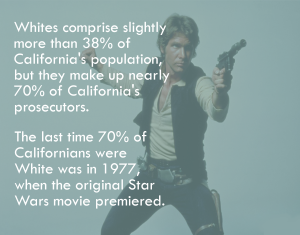Stanford Criminal Justice Center Report Finds California Prosecutors Do Not Reflect the State’s Diversity

While detailed information about the race and gender of law enforcement officers in the United States has been available for decades and has prompted many police departments to diversify their workforces, there has been virtually no publicly available information to answer the question of how representative prosecutors are of the communities they serve. Until now.
Stanford Law School students worked with the Stanford Criminal Justice Center to make the demographics of California prosecutors available for the first time. Data that the team gathered from prosecutors’ offices in 52 of California’s 58 counties, representing nearly 98 percent of the state’s population, found that whites, who comprise slightly more than 38 percent of the state’s population, hold nearly 70 percent of prosecutors’ jobs.
The last time 70 percent of Californians were white was four decades ago. California prosecutors, the report concludes, are “Stuck in the ‘70s.”
The team found that Latinos are the most poorly represented among prosecutors. Latinos represent almost 39 percent of the population in California but make up only 9 percent of California prosecutors.
In addition, the data collected showed that women are underrepresented in the supervisory ranks of prosecutors in California. Forty-eight percent of California prosecutors are female, but 41 percent of prosecutors with supervisory titles are women.
Importance of diversity
Those numbers are significant, the report says, because research has shown that criminal justice agencies are fairer, inspire more public confidence and are more likely to be seen as legitimate when they reflect the diversity of the communities they serve. In addition, the report notes that “the presence of minority attorneys in a prosecutor’s office may also make the office more likely to adopt policies and champion initiatives that are responsive to the concerns of minority residents.”
The students working on the study were enrolled in a practicum offered by the school’s Law and Policy Lab, where small teams work under close faculty supervision to help solve complex policy problems on a wide range of issues. The practicum was led by Debbie Mukamal, executive director of the Stanford Criminal Justice Center (SCJC) and Professor and SCJC Faculty Co-Director David Alan Sklansky.

“The most surprising thing was that Latinos are extremely underrepresented among prosecutors. I expected them to be underrepresented, but not by such a large percentage,” said one of the students, Isaiah Deporto, JD ’17.
Another student, Katherine Bies, JD ’17, described the difficulty in getting the data. “We tried collecting the data in bulk by sending out Freedom of Information Act requests to the federal Department of Justice and California DOJ and local Equal Employment Opportunity Commission offices, but not one of these organizations had records of the data. Instead, we had to call each office individually and, even then, there was no routine manner of collecting the data,” she noted.
The other students in the practicum were Darryl Long and Megan McKoy, both JD ’17.
Insufficient ‘pipeline’
In addition to highlighting disparities between the demographic breakdown of prosecutors in California and the residents they serve, the study notes a problem in the pool from which prosecutors are hired: lawyers. In California 79 percent of lawyers are white, whereas 6 percent are Latino. It cites the “pipeline” for lawyers – law schools – as another concern. That problem is not confined to California. While blacks, Latinos, Asian Americans and Native Americans comprise a third of the national population, they comprise only a fifth of law school graduates across the country and just over a tenth of attorneys practicing law.
The report suggests that future studies might address the effects and causation of the underrepresentation of Latinos among California prosecutors, as well as the underrepresentation of women in supervisory roles. They might also explore issues raised by prosecutor demographics on a national basis. “We need to better understand why the legal profession as a whole and, in particular, prosecutors’ offices, struggle to hire and retain minority and female lawyers,” said Bies.
Some of that work will begin soon at Stanford Law School. Mukamal and Sklansky are currently recruiting students for a follow-up policy practicum to be offered this fall.
Read an op-ed about the new study by Debbie Mukamal and David Sklansky in the Los Angeles Times.
Related story: SLS Professor Deborah Rhode comments on the problem of law school diversity in The Washington Post.
